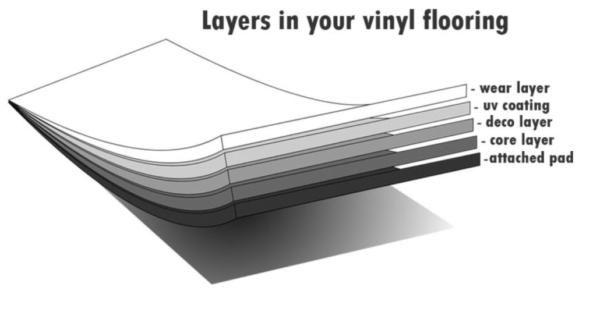
- Display 15 Products per page

LVP flooring reduces noise and provides comfort underfoot while offering the realistic appearance of hardwood or stone. Unlike rigid surfaces such as wood, ceramic tile or porcelain tile, vinyl plank flooring has a slight “give” that makes it a “resilient” flooring option. This means more comfort when walking and less noise when compared to hard surface alternatives.
LVP goes by many names in the flooring industry: Luxury Vinyl Tile (LVT), vinyl wood flooring, SPC Flooring (Stone Plastic Composite), waterproof flooring, vinyl flooring planks, and click flooring. These floating floors don’t need nailing or gluing to the subfloor, making installation quick and straightforward for homeowners.
The major advantage of LVP flooring is its versatility. You can install it over many existing surfaces, including old ceramic tile. With proper preparation, LVP tile flooring can go directly over that outdated kitchen tile, saving you money and mess from a full tear-out. LVP is also waterproof, scratch-resistant, and simple to clean, making it perfect for busy households with kids and pets.
For DIY fans, LVP stands out as one of the most approachable flooring options. The design consists of multiple layers: a durable wear layer on top, a vinyl print layer that creates the realistic wood or stone look, a rigid core, and often an attached underlayment. This construction creates a floor that’s not only beautiful but built to last.
Keeping LVP flooring looking its best requires minimal effort. For daily care, simply sweep or vacuum with a hard floor setting to remove dirt and debris. For deeper cleaning, a damp (not wet) mop with a mild cleaner works perfectly.
Many homeowners use a simple vinegar solution—one cup of white vinegar mixed with a gallon of warm water—which removes dirt without leaving residue. Avoid steam cleaners, waxes, and harsh chemicals that can damage the protective wear layer.
LVP flooring comes in countless styles and colors, including white, black, gray, brown, and even blue. The most popular looks mimic wood flooring or natural stone. Unlike real wood or stone, however, LVP needs no special treatments or refinishing—just basic cleaning keeps it looking fresh for years.
If you have questions about specific types or colors of vinyl plank flooring, or need professional design or installation help from our experts, call or visit Tile For Less in Salt Lake City!
Where can you install Luxury Vinyl Tile?
Luxury Vinyl Tile works well in bathrooms, kitchens, bedrooms, living rooms, and almost anywhere you’d typically find wood or traditional tile floors. Unlike natural wood, LVP is waterproof, making it superior for bathrooms and kitchens. You can also install LVP over existing tile for a simple, modern update.
How do you clean Luxury Vinyl Tile?
For daily cleaning, use a broom or vacuum to remove dust and debris. Keep your LVT free from abrasive materials and avoid harsh cleaners or scrubbers. Don’t steam clean vinyl plank flooring. Instead, use a damp cloth or microfiber mop with warm water and a small amount of pH-neutral dish soap. LVT shouldn’t be waxed as this will damage the surface.
Note: While these guidelines apply to most LVT products, always check the care instructions for your specific brand.
What types of furniture are safe to have on LVT?
Use felt pads under furniture to prevent scratches when pieces are moved. Avoid furniture with rollers as LVT click joints aren’t designed for “roll over” pressure. When moving large items across LVT, place a cushioned pad under a sheet of plywood to distribute weight evenly across the floor.
What is the best luxury vinyl plank flooring?
A floating floor plank with a 20 mil wear layer and attached pad offers the best performance. This thickness typically comes with a lifetime residential warranty. For DIY installation, choose products with the I4F drop-lock system, which installs 30% faster than standard click systems.
Quality LVP should be at least 4.5mm thick, UV stable, and approved for below-grade installation. Floating floors are common in homes, while glue-down planks are often used in commercial settings. At Tile For Less, we only sell LVP with attached antimicrobial padding to provide sound absorption and keep installation costs down.

How do you install rigid core luxury vinyl flooring?
While manufacturers have specific guidelines for warranty compliance, some standard rules apply:
Your subfloor must be LEVEL before installation. LVP installed over uneven surfaces will flex in low spots, putting pressure on click joints and eventually causing separation. We recommend Laticrete NXT Self Leveler to prep uneven floors.
What is the best brand of luxury vinyl flooring?
The “best” brand depends on your specific needs. Companies differentiate their products through features like stone-mixed cores, waterproofing qualities, attached padding, wear layer thickness, and special additives.
Consider these factors when choosing:
There’s no one-size-fits-all solution. At Tile For Less, we’ll help you find the best luxury vinyl flooring for your needs and budget.
Are transitions necessary for luxury vinyl plank flooring?
Yes. T-molding and reducers are the most common transition pieces, though end caps are sometimes needed. The material your vinyl is transitioning to will determine the appropriate piece. Many manufacturers offer matching transition pieces for a seamless look. If matching trims aren’t available, metal options work well. Talk to our flooring experts about options for your specific vinyl choice.